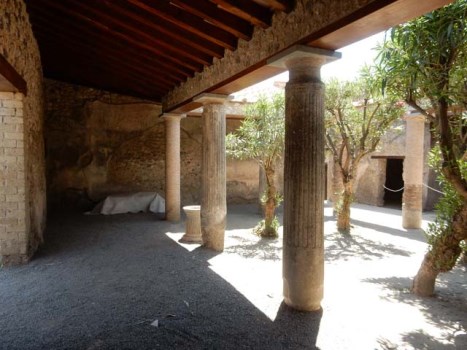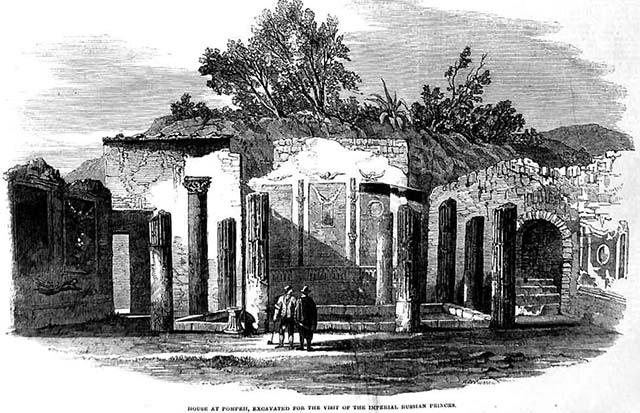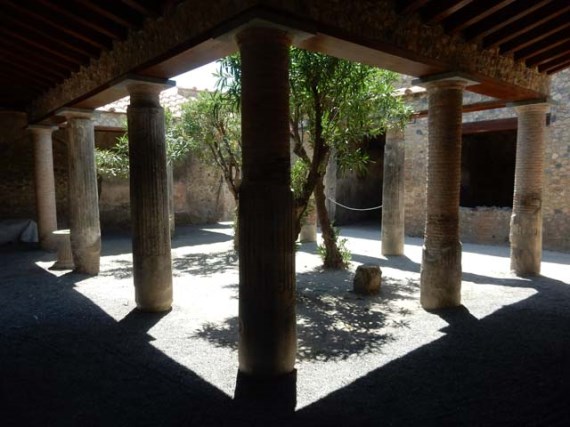



Address: Insula 1
Area: 740 square meters
Rooms: 21
The House of Siricus (Italian: Casa di Sirico or Domus Vedi Sirici), designated as VII.1.47 in Pompeii's archaeological grid, is a large and elegant Roman domus that exemplifies the architectural and decorative sophistication of Pompeii's elite during the Imperial period. Located in Regio VII, Insula 1, it has its primary entrance at number 47 on Via Stabiana (Strada Stabiana), with a secondary access from Vicolo del Lupanare at VII.1.25, making it a "double house" formed by merging two adjacent properties in the 1st century BCE. The house derives its name from its last known owner, Publius Vedius Siricus, a prominent figure in Pompeii's political and commercial circles who served as duumvir (a high magistrate) in 60 CE. Spanning a substantial area, it integrates residential, reception, and garden spaces, reflecting the owner's wealth from trade, as hinted by the mosaic inscription "SALVE LVCRV" ("Hail, profit" or "Welcome, money!") at the entrance. Excavated in phases between 1851 and 1873, the house was restored and reopened to the public in 2017 as part of ongoing conservation efforts at the Pompeii Archaeological Park. It is renowned for its Fourth Style frescoes depicting Trojan War myths and other scenes, many of which are now housed at the National Archaeological Museum of Naples (MANN), offering insights into Roman cultural ties to Greek mythology and the social aspirations of Pompeii's merchant class.
Dating to the 1st century BCE, the House of Siricus emerged from the unification of two smaller Samnite-era properties, one fronting Via Stabiana and the other Vicolo del Lupanare, during a period of urban expansion and Romanization in Pompeii after its conquest in 80 BCE. By the 1st century CE, it was owned by Publius Vedius Siricus, possibly alongside Vedius Nummianus (potentially a relative), who were part of the city's elite involved in politics and commerce. Siricus's role as duumvir in 60 CE places the house in the context of post-62 CE earthquake reconstructions and the Neronian era, when Pompeii experienced riots and imperial influences. The house was undergoing extensive decorative renovations at the time of the 79 CE Vesuvius eruption, which preserved its features under ash and lapilli. Excavations began in 1851, with further digs in 1857, 1862, and 1872, marking it as one of the first sites excavated stratigraphically in 1852. Post-excavation, it suffered from exposure but was restored by 2017, highlighting Pompeii's ongoing preservation challenges. The house adjoins the Stabian Baths and connects internally to VII.1.25 (House of the Russian Princes), underscoring integrated urban planning.
One of the frescoes. Most of the frescoes were taken to the Naples Museum.
The House of Siricus follows a classic Roman domus plan but with
adaptations from its merged origins, featuring an atrium-centric
design leading to private and garden areas. It spans two levels in
parts, with service spaces linked to adjacent properties. Rooms are
labeled per standard archaeological plans (e.g., from
pompeiiinpictures.com). Below is a room-by-room overview:
Entrance Corridor/Fauces (Room 1): Accessed from Vicolo del Lupanare
(VII.1.25), it features a mosaic threshold with the inscription
"SALVE LVCRV." The walls have roughly plastered and painted
decorations.
Atrium (Room 3): A hipped Tuscanic atrium serving as
the central hub, with a marble-faced impluvium for rainwater
collection, a labrum as a fountain, a marble table, a travertine
cistern mouth, and a broken money-chest base in the southwest
corner. It provides access to surrounding rooms and views toward the
tablinum and exedra.
Cubiculum/Bedroom (Room 4): In the southwest
corner of the atrium, with a recess for a bed in the northwest
corner.
Cella/Storage Room (Room 5): Adjacent to the tablinum,
with a blocked doorway reused for shelving.
Tablinum/Reception
Room (Room 6): At the rear of the atrium, used for business and
client meetings, with views across the atrium.
Corridor (Room 7):
Connects the atrium to the peristyle garden.
Triclinium/Dining
Room (Room 8): On the northeast side of the atrium, with a wide
window opening to the peristyle's west portico, closable with
folding leaves. It housed candelabra and now displays plaster casts
(though originally from elsewhere).
Corridor (Room 9): Leads
north from the atrium to the kitchen area in adjacent VII.1.46, with
a niche in the east wall.
Exedra/Open Hall (Room 10): A spacious,
lofty room in the northwest corner of the atrium, notable for its
threshold and floor, serving as a reception or display area.
Room
(Room 11): On the west side of the atrium, with a window onto Vicolo
del Lupanare and a basin in the northwest corner.
Room (Room 17):
Features a doorway leading west to Room 12 and views of a lararium
in VII.1.46.
Peristyle/Garden (Room 19): A rear garden enclosed
by a portico with five columns and a low wall, including a cistern
mouth on the north, a terracotta puteal on the west, and four small
columns supporting a pergola over a wooden triclinium. It connects
via steps to a second peristyle (Room 31) in VII.1.25.
Small
Rooms (Rooms 20, 21, 22): In the southwest corner of the peristyle;
Room 21 has a low south wall with a narrow passage containing lead
pipes linked to the Stabian Baths, and Room 22 features painted
plaster interiors.
The layout emphasizes functionality for
elite social life, with natural light from the atrium and garden,
and practical elements like water systems.
SALVE
LUCRUM, Glory to profit
Decorations are predominantly in the Fourth Style (post-62 CE),
characterized by intricate mythological scenes, vibrant colors, and
architectural illusions, reflecting the ongoing renovations at the
time of the eruption. Key features include:
Exedra (Room 10):
Richly adorned with yellow compartments on red backgrounds, bold
scroll borders with quadrupeds and winged cupids, and black podiums
divided into squares with festoons, candelabra, bucrania, and
Bacchic vases. Frescoes (about one-third life-size, now in MANN)
depict: Neptune/Poseidon and Apollo building Troy's walls (west
wall); Thetis demanding Achilles' arms from Vulcan/Hephaestus (east
wall); Drunken Hercules with Omphale (north wall). Surrounding
motifs include Muses (e.g., Polyhymnia, Urania, Euterpe,
Clio/Calliope, Erato with lyre, Thalia, Melpomene, Terpsichore),
griffins, centaurs, Apollo in a tholos, and landscapes. The ceiling
had gilt bas-reliefs and stucco acroteria with beasts.
Triclinium
(Room 8): Faded Fourth Style frescoes on black backgrounds,
including a warrior and girl, the dressing of Paris, fleeing
Maenads, and the wounded Aeneas treated by Iapyx with
Venus/Aphrodite and Ascanius (MANN inv. 9009).
Peristyle (Room
19): A lost frieze on the west wall depicting gladiators' weapons,
documented in 19th-century watercolors (MANN inv. ADS 1206–1208).
Mosaics and Floors: Entrance mosaic "SALVE LVCRV"; exedra threshold
in white with black borders and half-moon shields; exedra floor with
black fillets, central mosaic of double-handled wine jars (diotae)
and vine shoots around giallo antico marble squares.
Graffiti
includes the entrance inscription "SIRICVM II . VMIVM. MODESTVM. AED
SIRICE FAC FACIAS" (CIL IV 805), an electoral notice supporting
Siricus for aedile.
Artifacts comprise a bronze seal "SIRICI"
from the tablinum, a gold ring with a cornelian portrait head of a
man, an Isis figurine, candelabra from the triclinium, and lead
pipes in Room 21 linked to the baths. Plaster casts of victims are
displayed in the triclinium but originate from Vicolo degli
Scheletri.

Pompeii. 1853. A drawing called “House in Pompeii” was excavated for the visit of the imperial Russian princes. Hence the second name "House of Russian Princes"
The House of Siricus provides a vivid snapshot of Pompeian elite life, blending politics, commerce, and Hellenistic-inspired art, with its Trojan-themed frescoes symbolizing cultural prestige and possibly ties to imperial patronage under Nero. Its merger of properties and trade motifs underscore economic dynamics, while the renovations highlight resilience post-earthquake. As part of the UNESCO-listed Pompeii Park, it is open daily (typically 9:00 AM–7:00 PM April–October; shorter in winter), included in the €18 general ticket. Visitors can explore via guided tours, noting the faded on-site frescoes (best viewed at MANN) and the garden's reconstructed elements, offering reflections on ancient prosperity amid volcanic ruins.
